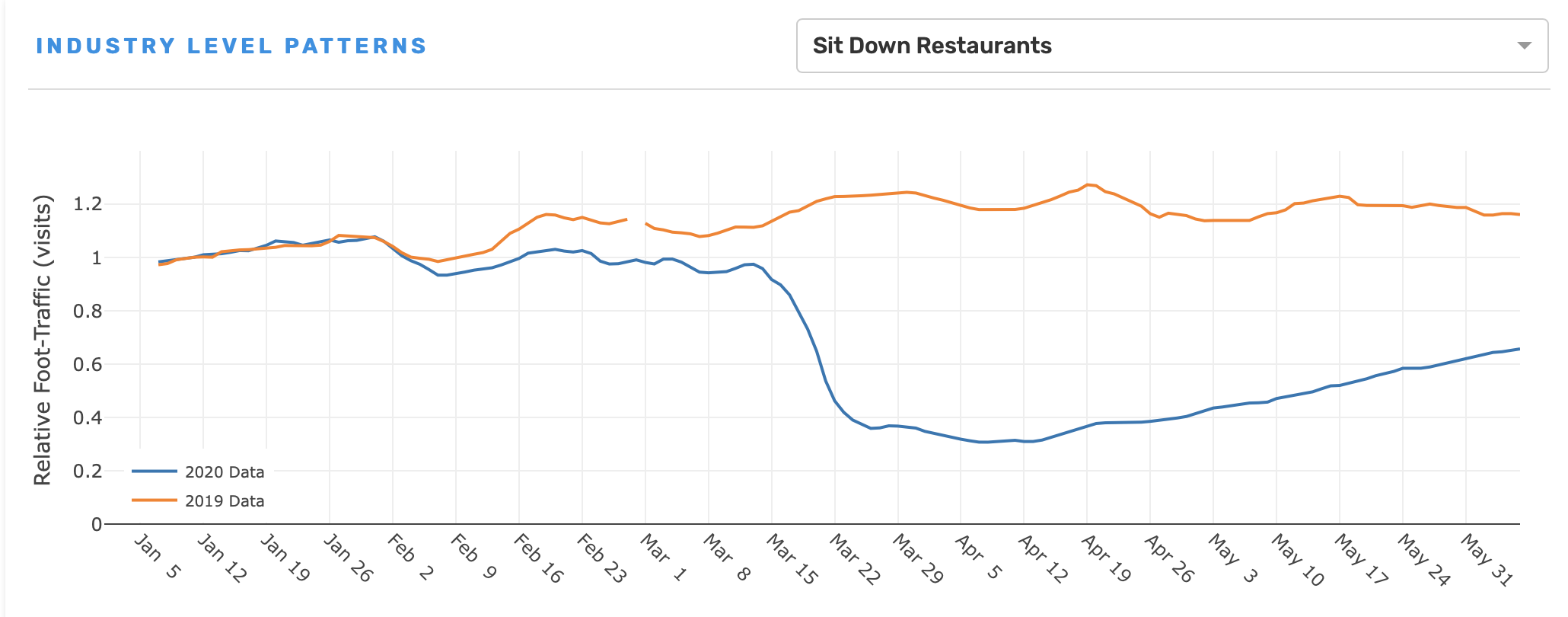
Where are we today?
In today’s blog, I will discuss the state of consumer spending nationwide and in Utah, specifically related to food and markets of interest to you. I’ll also cover meat processing trends and agricultural labor issues.
While consumer spending overall nationwide is still down 15% from January 2020 levels (as of May 10, 2020), it has rebounded significantly since its low of -33% the end of March (Source). Figure 1 provides an overview of the percentage change in spending from 2019 for the week ending April 1. Food delivery and online grocers saw large increases in spending over 2019, as well as meal kits, alcohol, and home improvement. Fast food, lodging, and airlines were some of the hardest hit industries.
Figure 1: Change in Consumer Spending from 2019, ending April 1, US. 
Source: https://www.nytimes.com/interactive/2020/04/11/business/economy/coronavirus-us-economy-spending.html
Grocery and Restaurant Spending
Nationwide grocery spending is still up 20.4%, but down from its high of 73.7% on March 18. Restaurant and hotel spending remain low at -49.1% but has improved since its low of -66.7% on March 31 (Source). As shown in Figure 2, supermarket foot traffic is approaching 2019 levels, but has dropped off from mid-March highs. Foot traffic at sit-down restaurants has rebounded substantially (as of May 31) over early April lows, but is still about 40% under 2019 levels.
In Utah, consumer spending was at -11.5% on May 10, 2020, grocery spending up 30.8%, down from a high of 109% March 16, and restaurant spending is down 46.6% from January 2020 levels (Source).
Figure 2: Relative Foot Traffic (Visits) for Supermarkets and Sit-Down Restaurants, 2020 vs 2019, US.

Source: https://www.safegraph.com/dashboard/covid19-commerce-patterns
As you have probably noticed, the grocery store shelves are looking more “normal” these days, with few, if any, out-of-stock items, even toilet paper. Our food supply chains are very efficient and employ “just-in-time” systems, where grocery retailers track customer behavior over time and only order what they need. This means there isn’t any extra inventory, and thus when consumers were told to stay home in mid-March, the spike in retail grocery purchases shocked the system and created shortages. These short-term shortages are ironed out in the longer-term as we have seen over the last month.
Meat Processing
Meat processing volumes declined sharply from 2019 levels (up to 40%) in late April 2020, primarily due to processer closures amidst COVID-19 outbreaks at those facilities (Figure 3). Workers at many facilities were quarantined and others walked out demanding safer working conditions and PPE. As of May 18, cattle and hog processing levels were almost back to 2019 levels. Chicken processing levels were relatively unaffected. Meat processing is highly concentrated, as 10 plants slaughter 63% of all cattle and 15 plants slaughter 59% of all hogs in the US. Hence, the closing of just 3-4 plants can cause major disruptions in the meat supply.
Figure 3: Percentage Change in Animals Processed in 2020 vs. 2019.
Source: www.JaysonLusk.com
Agricultural Labor
Outbreaks of COVID-19 in the agricultural labor force are a primary concern for the upcoming harvest season. Recent articles have highlighted the degree of infection in several areas of the country (As Hundreds of Farmworkers Test Positive for COVID-19, Many Remain Unprotected: Every Single Worker Has Covid at One U.S. Farm on Eve of Harvest). This situation may create shortages in the food system and also lead to farm losses due to the inability to harvest crops when necessary. Farm worker infections may also lead to consumer concerns regarding food safety, especially for non or low processed foods, such as fresh produce. While this may create opportunities for local growers who can verify a healthy workforce, it’s hard to say at this point.
Local growers I spoke with highly suggest only employing farm workers who can be trusted to follow COVID-19 safety protocols off-farm, having all employees wash their hands upon entrance to the farm, and maintaining six feet of distance at all times while working. The CDC has published COVID-19 guidance for agricultural workers and employers (CDC guidance).
Please be aware that UDAF has posted new “orange and yellow phase” guidelines for farmers’ market sales on their COVID-19 website. The majority of the Utah farmers’ markets will be operating this summer, which is very good news. I look forward to seeing many of you at market!
That’s all for now. If you have a topic you would like to see covered in a future blog, feel free to contact me.
Stay healthy!
Kynda Curtis, USU Extension Ag and Food Marketing Specialist
kynda.curtis@usu.edu
Online workshops, courses, webinars, and podcasts:
- USDA FSA Coronavirus Food Assistance Program (CFAP) Stakeholder Organizations Webinar: https://www.fsa.usda.gov/programs-and-services/outreach-and-education/webinars/index?utm_medium=email&utm_source=govdelivery
- USU Extension and Utah FSA Coronavirus Food Assistance Program (CFAP) Webinar: https://extension.usu.edu/apec/farm-financial-health
Resources:
- USU Extension COVID-19 Resources: https://extension.usu.edu/covid-19/
- Marketing in Motion Blog Posts: https://extension.usu.edu/apec/news/
- UDAF Utah’s Own Program: https://www.utahsown.org
- UDAF COVID-19 Resources: https://ag.utah.gov/covid-19-news-and-updates/
- Taxes and Federal Programs: https://ruraltax.org
Disclaimer: This blog is for information purposes only. USU Extension does not endorse any specific product or service that may be mentioned here in.

